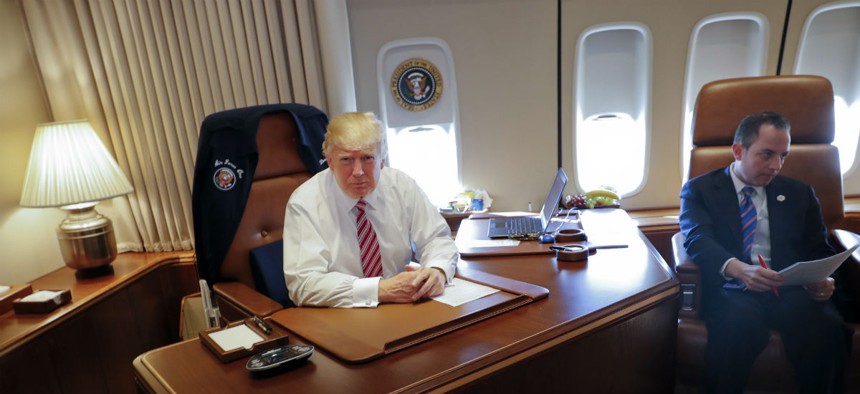
President Donald Trump, with his Chief of Staff Reince Priebus, sits at his desk on Air Force One on Thursday. AP Photo/Pablo Martinez Monsivais
How Reporters Misread Trump’s First Week in Office
The new president’s opening act has disrupted governing traditions, but it’s the second act that matters most.
Let’s look back at President Donald J. Trump’s amazing first-week flurry of executive orders: Not since the media coalesced around the “Trump can never win” meme have so many reporters gotten so much wrong. Much of the coverage has been apocalyptic, but most of the orders have been more pop than sizzle.
What a boffo opening! The Trump team actually managed to convince reporters—and subsequently most Americans—that the flurry of executive orders actually did something. They’re part of a deliberate chaos, masterfully orchestrated to create as much disruption to Washington’s governing traditions as possible—and from the chaos, to give Trump the chance to do what he really wants to do.
But the challenge comes after the curtain rises on Trump’s second act: how he will move past the announcements of ideas to building capacity to get results. Steven Suskin’s book on the biggest bombs in Broadway musicals, Second Act Troubles, points to the real issues. There’s a long list of big plays with big stars and great opening numbers that fell apart in the second act. Sometimes personality conflicts and artistic differences shredded the play. Sometimes costly rewrites and recasting of stars undermined the ability to translate a big start to an effective finish. Sometimes the team just didn’t know where the play was going. It’s easy to get swept up by a great opening number—and then be let down by a play that fails to deliver in the second act.
Trump built his reputation on The Art of the Deal. He loves pushing his opponents back on their heels, unsettling them to find weak spots and opportunities, and making deals to win the battles he chooses to pick. And reporters took the bait.
If you listened to the stories about the executive order on the Affordable Care Act, you would have believed that Trump’s order had chopped Obamacare off at the knees. In fact, the order did little more than tell everyone what we already knew (that Trump wanted to repeal-and-replace Obamacare as soon as possible) and that he wanted to put the brakes on any new administrative actions to support Obamacare (which were unlikely anyway).
If you listened to stories about the wall with Mexico, you would have expected construction to start within weeks. In fact, the order starts the planning, but actually building that 2,000-mile wall will require congressional appropriations. Conservatives on the Hill are already queasy about digging the deficit deeper and almost everyone is worried about picking a trade war with Mexico.
If you listened to stories about the federal hiring freeze, you would have been convinced that the administration was slashing federal employment. In fact, the order has a giant escape clause, with exemptions for “national security or public safety.” Agency heads get to make the call about what qualifies. And it’s not clear that anyone in the White House is keeping score on these exceptions.
It’s certainly not the case that Trump’s executive actions are nothing burgers. But unlike most presidential orders in the past, the first-week flurry is more like a set of flares in the sky, to signal some future direction, rather than a strategy for how to get there.
The challenge facing Trump—and this is what many reporters missed—is how the second act opens. For example, just how will Trump pay for the wall? Who is actually going to build it? The federal government inevitably will contract it out, and almost everything government tries to do big, fast, and new creates the foundation for fraud, waste, abuse, or mismanagement—especially when it doesn’t pay sufficient attention to building the capacity inside government to manage those contractor relationships. (Remember the launch of Obamacare?)
Or look at the hiring freeze executive order. Missing in most of the coverage is that it orders the Office of Management and Budget and the Office of Personnel Management to come up with a plan to shrink the workforce through attrition—within 90 days. While the clock is ticking, Trump has yet to even nominate a leader for OPM, and his choice to lead OMB has not been confirmed. We can be sure of one thing: we don’t need a smaller workforce as much as a different workforce, and attrition is no way to get there. Relying on attrition guarantees that we won’t end up with the right skills in the right places. Unless Team Trump quickly writes a second act that gets government the people skills it needs, the stage will be set for a new version of the troubled second act that crippled Bush (with Katrina) and Obama (with the Obamacare website launch).
When a Broadway play fails because it can’t solve second act troubles, investors lose money and actors lose face. In the White House, there’s no second chance to get the second act right. How the Trump White House moves from its boffo opening number to a second act that closes the deal is the real story.
Donald F. Kettl is a professor and former dean of the University of Maryland School of Public Policy.







